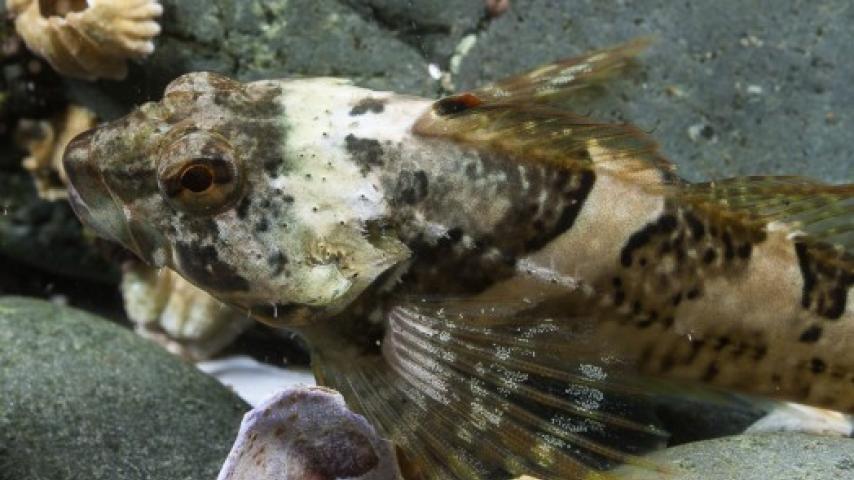Tidepool Sculpin (Oligocottus maculatus)
At especially low tides, walk slowly toward any tidepool on a rocky/sandy coast and watch for a little (up to 9 cm) fish with a fairly big head and big dark blotches across its back.

KINGDOM Animalia - PHYLUM Chordata - CLASS Osteichthyes - ORDER Scorpaeniformes - FAMILY Cottidae
Its very large dorsal and anal fins are prominent features. Each tidepool may contain several of them, and when disturbed they will shoot forward like a flash with a flick of their tail and settle to the bottom again, superbly camouflaged wherever they land.
As the tide recedes some of these sculpins become stranded under rocks and logs. Fortunately for them, they have the ability to extract oxygen directly from the air; in other words, they breathe air. They are not alone in that; fish all over the world that live in environments that may at times be oxygen poor are able to breathe air.
Sculpins are carnivores, and this little species hunts for the small crustaceans and worms of several types that are common in its habitat. It is similarly sought by larger predatory species. Most sculpins are protected from predation by sharp spines on their head and gill covers, but this species is not very heavily spined. In fact, it is scaleless, unusual for a fish but not so unusual for a sculpin, many of which lack scales. Perhaps it makes up in speed and camouflage what it lacks in armament.
Because they are small, easily acquired, and easily kept in aquaria, Tidepool Sculpins have been the subject of some interesting experiments. They can detect the odor of one of their predators, the Kelp Greenling, by smell. They can also detect the smell of an injured individual of their own species, and in both cases, they move around less and seek cover.
Tidepool Sculpins mature in one year and may live as long as five. During the summer reproductive season, the male transfers sperm to the genital canal of the female, where they attach to eggs, but actual fertilization does not take place until the eggs are laid into sea water. Females lay several batches of eggs each year. The eggs stick to the substrate but, unlike those of many other sculpins, are not guarded by either adult.
They are rather sedentary fish, remaining in a small home range throughout the year. If displaced by a curious researcher, however, they have been able to return to their limited home range from as much as 100 meters away, using their well developed sense of smell. These tiny fish in their own way are just as impressive as the salmon that find their home streams after spending time out in the ocean!


